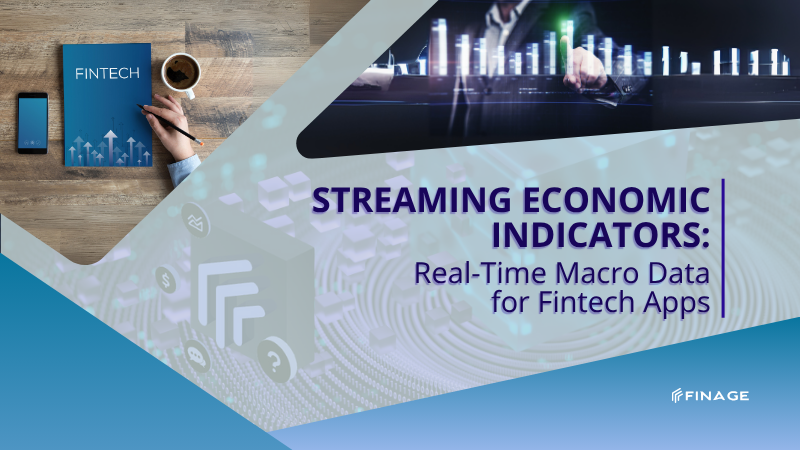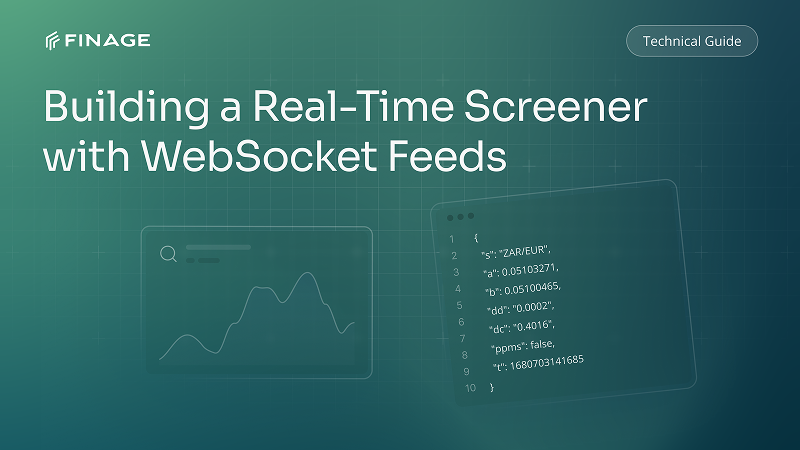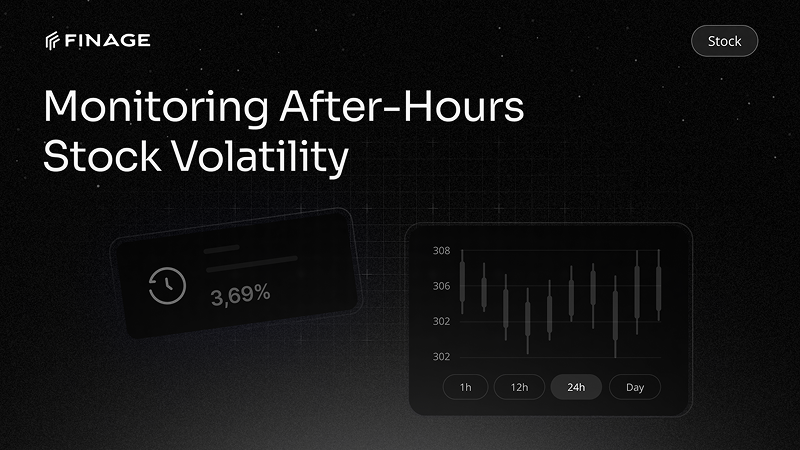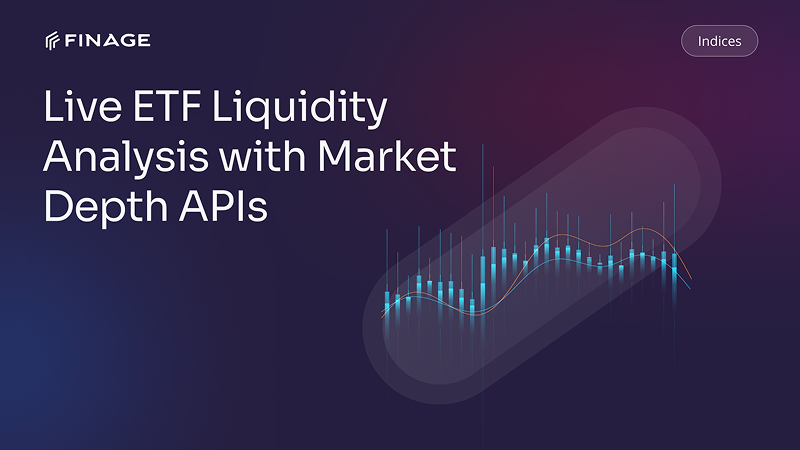Streaming Economic Indicators: Real-Time Macro Data for Fintech Apps
13 min read • June 22, 2025

Introduction
Macroeconomic indicators—interest rates, inflation reports, employment data—drive markets at every level. From foreign exchange fluctuations to stock market momentum, these indicators shape investor sentiment and capital allocation across the globe. But while most economic data has traditionally been distributed in static reports and PDF releases, the demand for real-time, API-accessible macro data is growing fast.
For fintech apps, access to streaming economic indicators can unlock a new layer of insight. Whether it's an investment platform adjusting asset allocations based on CPI trends, or a dashboard alerting users to unexpected jobs numbers, integrating macroeconomic signals into your application can deliver real-time context that was previously out of reach.
In this article, we explore how developers can integrate streaming economic data into fintech products, how to align macro feeds with user goals, and what infrastructure is required to handle these signals reliably at scale.
Table of Contents
- Why Macroeconomic Data Matters in Fintech
- Key Economic Indicators That Move Markets
- Real-Time vs. Delayed Economic Feeds: What's Possible Today
- Aligning Macro Data with User Expectations
- Using Economic Indicators to Trigger Alerts and Recommendations
- Designing UX for Streaming Macro Events
- Technical Considerations: Latency, Accuracy, and Updates
- Use Cases Across Trading, Banking, and Investment Apps
- How Finage Supports Streaming Economic Data at Scale
- Final Thoughts: Empowering Fintech with Real-Time Macro Insight
1. Why Macroeconomic Data Matters in Fintech
At a high level, macroeconomic indicators represent the health of an economy. For decades, institutional investors, central banks, and portfolio managers have relied on these metrics to guide decisions around risk, allocation, and timing. But now, retail investors and digital finance platforms want that same insight—delivered faster and integrated into their daily tools.
Macroeconomic signals shape financial sentiment
Changes in inflation, interest rates, and employment levels don’t just impact government policy—they affect how people invest, spend, and borrow. Even small movements in these numbers can lead to big shifts in:
- Equity market volatility
- Currency strength
- Bond yields
- Commodity pricing
An app that can reflect these shifts in real time offers users a major edge—context that turns raw numbers into strategic decisions.
Democratizing access to institutional-level insight
Traditionally, macro data was gated behind institutional dashboards or released in formats too delayed or static to use dynamically. Fintech tools can change that by delivering the same information with low latency, formatted for mobile or web experiences.
With real-time macro updates, apps can surface insights like:
- “Interest rate decision coming in 10 minutes”
- “Unemployment rate surprise: market reaction expected”
- “Your portfolio includes assets sensitive to CPI – see how they’re affected”
This kind of functionality builds trust, engagement, and user confidence—especially in volatile markets.
2. Key Economic Indicators That Move Markets
Not all economic data is created equal. Some indicators are leading, offering hints about where the economy is headed. Others are lagging or confirmatory, useful for analyzing trends that have already unfolded. For fintech apps looking to surface real-time insight, knowing which indicators matter most—and why—is essential.
Central bank decisions
Interest rate announcements and policy statements from institutions like the Federal Reserve, ECB, or Bank of England are among the most market-moving events. They influence:
- Currency exchange rates
- Stock market sentiment
- Bond pricing and yield curves
These events are scheduled and closely watched. Even the language used in a central bank press release can shift markets.
Inflation data
Consumer Price Index (CPI), Producer Price Index (PPI), and other inflation metrics reflect the cost of living and purchasing power. They directly influence:
- Central bank policy decisions
- Commodity and FX markets
- Investor behavior regarding inflation-hedging assets
Streaming this data allows fintech platforms to adjust dashboards, alerts, or portfolio recommendations in sync with real-world cost pressures.
Employment statistics
Job creation, unemployment rates, and wage growth metrics provide insight into the health of the labor market—one of the most fundamental components of economic growth. Key reports like the U.S. Nonfarm Payrolls (NFP) routinely move equity, bond, and currency markets within minutes of release.
GDP and growth indicators
Gross Domestic Product (GDP) releases summarize economic expansion or contraction. Other growth-related indicators include:
- Industrial production
- Retail sales
- Business sentiment indices (e.g., PMI)
These help contextualize broader market performance and investor sentiment.
Consumer and business confidence
Surveys like the University of Michigan Consumer Sentiment or the ISM Manufacturing Index can indicate shifts in behavior before they appear in spending or employment. While less explosive than CPI or NFP, they’re valuable for early detection of turning points.
3. Real-Time vs. Delayed Economic Feeds: What's Possible Today
When it comes to integrating economic data into fintech apps, timing is everything. But real-time doesn’t always mean “to the second,” and not all macro data is available the same way as market tick data. Understanding the difference between truly real-time feeds and structured delayed releases helps you build smarter, more reliable applications.
Official release schedules
Most economic indicators are published by government agencies or central banks according to strict calendars. These include:
- Monthly inflation reports (e.g., CPI, PPI)
- Quarterly GDP figures
- Weekly jobless claims
- Scheduled rate decisions by central banks
These aren’t live streams in the traditional sense, but high-impact scheduled events. Fintech apps benefit by integrating these moments into their data flow—pulling the data as soon as it's released and surfacing it to users with minimal delay.
Streaming alerts and pre-release signals
While the actual numbers aren’t available before the scheduled release, apps can still provide value in the lead-up:
- Countdown timers to major events
- Analysis of forecast vs. prior numbers
- Real-time push alerts when new data is published
This "pseudo-real-time" experience helps users prepare for key market moments—even when the data is not continuous.
Truly live macro sources
Some macro data—especially from market-based indicators like real-time yield curves, swap rates, or inflation expectations—can be streamed continuously. These indicators are derived from live market behavior rather than static reports, and can be used to:
- Gauge forward-looking policy sentiment
- Monitor real-time shifts in inflation risk
- Feed algorithmic models reacting to macro trends
Using APIs that provide live versions of these signals adds depth to your real-time macro layer.
Practical limitations
Not all regions or agencies release machine-readable data. Some updates may be delayed by seconds or minutes depending on formatting, distribution channels, or data providers. Apps should design around this by:
- Flagging when data is newly available
- Distinguishing between live and scheduled sources
- Implementing fallbacks for missed or delayed updates
4. Aligning Macro Data with User Expectations
Delivering economic data isn’t just a technical challenge—it’s a product decision. Fintech users don’t want raw spreadsheets or academic charts. They want timely insights that connect to what they’re trying to do, whether that’s investing, saving, managing risk, or making sense of market volatility.
Know your user’s context
Different users interpret the same macroeconomic signal in very different ways. A rise in interest rates might mean:
- Higher loan costs for consumers
- Lower bond prices for investors
- Currency strength for FX traders
- Stock market volatility for retail investors
When designing your integration, focus on what the data means to the user, not just what the number is.
Use relevance filters
Avoid overwhelming users with every new economic release. Instead, filter or prioritize:
- By asset exposure (e.g., highlight CPI if the user owns inflation-sensitive ETFs)
- By geography (e.g., only show Eurozone data to European investors)
- By portfolio impact (e.g., flag rate hikes that may shift stock-bond correlations)
A tailored experience makes macro data feel useful, not distracting.
Build around expectations, not surprises
Some macro events are widely anticipated. Give users time to prepare with:
- Countdown timers for upcoming releases
- Brief previews with consensus forecasts
- Summaries of why the indicator matters
Then, when the data arrives, surface it clearly and interpretively: “Unemployment fell more than expected. Here’s how markets are reacting.”
Offer layered depth
Power users want raw data. Casual users want summaries. Let them choose. For example:
- Show a short headline and reaction summary by default
- Let users tap or expand to see the full release details, historical comparisons, and charts
This balances accessibility with sophistication—two things often in tension in fintech UX.
5. Using Economic Indicators to Trigger Alerts and Recommendations
Macroeconomic data becomes exponentially more useful when it's tied to actions. Rather than just displaying numbers, fintech apps can use this data to trigger real-time alerts, offer strategic recommendations, or guide users through periods of economic uncertainty.
Intelligent alerting
Instead of flooding users with raw updates, build alerts that respond to:
- Surprises in key releases (e.g., CPI much higher than forecast)
- Deviations from expectations (e.g., central bank holds rates when hike was expected)
- Threshold conditions (e.g., inflation crosses 4% for the first time in a year)
Contextual triggers based on portfolios
When users connect portfolios or watchlists, macro alerts become even more powerful. For example:
- “You own bank stocks. Rising rates could benefit this sector.”
- “You’re exposed to EM debt. US rate hikes may increase volatility.”
- “Gold and inflation tend to move together—consider reviewing your holdings.”
These aren’t generic news items—they’re personalized, real-time nudges based on live macro data.
Behavior-based recommendations
Economic shifts often call for adjustments. Apps can support users by offering:
- Allocation tips based on policy cycles
- Reminders to rebalance after macro volatility
- Suggestions to learn more: “Explore assets that perform well in high inflation periods”
These prompts turn passive awareness into active engagement.
Trigger educational journeys
Economic events also create natural learning moments. When major data is released, link users to:
- Short explainers (“What is the Fed Funds Rate?”)
- Videos or infographics showing historical impacts
- In-app simulations or tools that show “what if” scenarios
This enhances trust while deepening the user’s financial literacy.
6. Designing UX for Streaming Macro Events
Macroeconomic data has traditionally lived in analyst reports and institutional dashboards—dense, delayed, and inaccessible to everyday users. But today’s fintech apps are changing that. With the right design, real-time macro events can become clear, contextual, and even actionable for everyone.
Present headlines, not spreadsheets
Users aren’t looking for data dumps—they’re looking for insight. Instead of listing the full data release:
- Surface a short, clear summary: “US CPI rose 0.6% in May, above forecast”
- Use clear visual indicators: up/down arrows, color cues, trend markers
- Place macro headlines next to portfolio or market views, not in a separate tab
This keeps the experience immediate and relevant.
Build around scheduled events
Streaming macro UX isn’t just about what happens—it’s about what’s coming. Integrate:
- Countdown clocks for upcoming releases
- Time-zone-adjusted event reminders
- “What to watch” explanations before key indicators drop
This turns macroeconomic data into a feature users anticipate, not just react to.
Design for disruption
Macroeconomic events often cause volatility. Your UX should help users:
- Understand what’s normal vs. unusual
- See the impact on their holdings or watchlist
- Explore new options without fear
Show changes in volatility or correlations post-release. Offer quick tools like “view safe-haven assets” or “compare past rate hikes.”
Let users choose depth
Some users want the number. Others want the context. Let them toggle or expand:
- “Headline only” vs. “full release breakdown”
- Summary charts with optional data tables
- Simple explanations with deeper dives behind a tap
This layered experience keeps the interface clean while still offering depth to those who want it.
7. Technical Considerations: Latency, Accuracy, and Updates
Streaming macroeconomic data sounds straightforward—until you're dealing with real-world release formats, timing constraints, and user expectations. To ensure your app performs reliably, you need to account for the technical challenges that come with high-impact, time-sensitive data.
Latency at release time
Most economic indicators are released at set times—often 8:30 AM or 2:00 PM local to a major financial hub. At those moments, demand surges as news terminals, algorithms, and apps all compete to access and publish the same data. To manage this:
- Ensure you use a provider with low-latency infrastructure close to source endpoints
- Design your backend to process and distribute new data in milliseconds, not seconds
- Stagger non-essential app tasks around key release windows to preserve responsiveness
Precision in timestamps
Economic data must be timestamped precisely. Even a few seconds’ drift can confuse automated alerts or trigger premature reactions. Your system should:
- Normalize timestamps to UTC
- Distinguish between release time and data effective time
- Apply consistent formatting for historical comparison and sorting
Error handling and fallback logic
Data feeds may occasionally deliver null values, delayed releases, or formatting changes from source agencies. Apps must:
- Validate incoming macro data against schema and expected fields
- Display fallback messages like “Data delayed—refreshing shortly”
- Maintain the last known release to avoid blank sections in the UI
Failing gracefully during a high-profile event is better than freezing or misinforming.
Regional and versioning complexities
Economic data isn’t globally standardized. For example:
- Europe reports CPI using HICP
- Different countries may use different fiscal calendars
- Some regions revise earlier figures without prior notice
Design for these inconsistencies by tagging data with origin, version, and source notes where possible.
8. Use Cases Across Trading, Banking, and Investment Apps
Real-time macro data isn’t just for high-frequency traders. Across fintech verticals, economic indicators can unlock smarter features, more engaging interfaces, and stronger user retention. Here’s how different product types are putting macro data to work.
Trading platforms
For trading apps—especially those offering forex, commodities, or equity derivatives—macroeconomic data is critical to:
- Drive real-time news overlays on charts (e.g., “Fed decision here”)
- Trigger volatility alerts or risk warnings
- Support macro-sensitive strategies like carry trades or rate arbitrage
Integrating macro events keeps traders in sync with the big picture—without leaving your platform.
Investment and portfolio apps
Longer-term investors also benefit from macro awareness. These platforms can use economic data to:
- Offer allocation tips during rate cycles or inflation shifts
- Provide commentary alongside portfolio changes
- Highlight which holdings are most affected by new data releases
This turns passive investing into an informed, guided experience.
Digital banks and budgeting tools
Macroeconomic data impacts daily financial decisions, too. Banks and budgeting apps can:
- Alert users to interest rate changes affecting loans and savings
- Offer personalized savings tips during inflation spikes
- Explain how employment data may shape lending or deposit conditions
Here, macro data becomes a layer of financial education and support—not just market context.
Wealth management and robo-advisors
For advisory platforms, macro data enhances trust and transparency. These systems can:
-Share insights into how policy shifts affect rebalancing logic
-Use economic outlooks to justify asset class weighting
-Offer macro-themed portfolios tied to growth, inflation, or central bank cycles
This positions macro insight as a core part of strategic guidance—not just peripheral noise.
9. How Finage Supports Streaming Economic Data at Scale
Integrating macroeconomic signals into your fintech product requires more than access to numbers—it demands infrastructure that’s fast, consistent, and reliable. That’s where Finage delivers a clear advantage.
Finage offers:
- Streaming access to key economic indicators, including inflation, employment, interest rates, GDP, and more
- Low-latency delivery from global data sources, with endpoints optimized for speed and stability
- Normalized, developer-friendly data formats, reducing the friction of parsing and integrating across multiple asset classes or regions
- Consistent symbol and event metadata, so your systems always know when and how to trigger updates
- Unified API access for macro, equities, forex, and crypto—making it easy to build multi-layered products
Whether you’re surfacing a single macro alert or powering an entire data-driven advisory engine, Finage helps you move quickly and scale confidently.
10. Final Thoughts: Real-Time Macro Data as a Fintech Differentiator
Macroeconomic data isn’t just for economists anymore. It’s becoming a core ingredient in how fintech apps guide users, shape financial decisions, and build trust. Whether you’re serving active traders, passive investors, or everyday consumers, real-time macro awareness adds context that enhances every experience.
And as fintech continues to move faster—blending automation, personalization, and education—access to clean, timely economic indicators will set apart the platforms that simply react from those that lead.
With the right data infrastructure, your app can help users understand not just what’s happening in markets—but why.
You can get your Real-Time and Historical Stocks Data with a Stock Data API key.
Build with us today!
Claim Your Free API Key Today
Access stock, forex and crypto market data with a free API key—no credit card required.

Stay Informed, Stay Ahead
Finage Blog: Data-Driven Insights & Ideas
Discover company news, announcements, updates, guides and more


